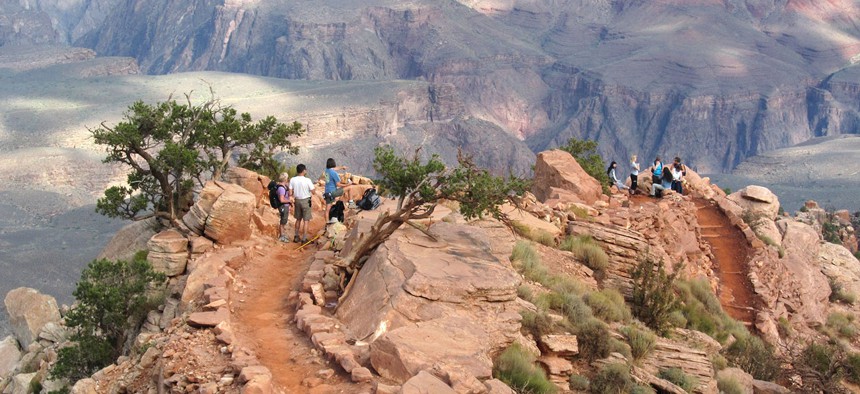It Costs U.S. National Parks almost $1 Million a Year Each to Keep Looking Natural
Without intervention, our park system would be a complete mess.
When visitors to the Grand Canyon National Park peer over the edge of the vast expanses, they often assume the ground below is completely untouched—as wild as the day 16th-century conquistadors stumbled upon the canyon.
What they don’t see are the weedwackers cutting up invasive plants, the roads designed to keep visitors moving seamlessly through the park, and the rangers inspecting far-off gravel quarries for foreign seeds that could hitch a ride on the purchased construction material. Not to mention the prescribed fires, animal tagging, and constant hunt for endangered saplings.
In fact, vegetation and wildlife experts spend entire careers making sure national parks look natural while unnaturally—but carefully—balancing the ecosystem’s needs and visitor safety.

Grand Canyon Association volunteers planting the new demonstration garden on the South Rim in September 2016. (NPS)
“It takes a lot of effort to restore lands that are disturbed and make them look pristine,” says Grand Canyon vegetation program manager Lori Makarick. It takes 14 staff members, 11 interns, and about $900,000 a year to keep Grand Canyon National Park looking natural—and that’s just for managing the plants. Makarick says it’s not enough: her department is understaffed (she’s the only one full-time) and she has to turn away volunteers because there’s no one to manage them all.
Every time a visitor steps on a path, a little bit wears away. Every time someone drives through the park, a few foreign seeds drop to the ground. Habitat managers chart out invasive species and safety risks, such as eroding banks along popular trails that need to be built back up, and plan out ways to remove invasive plants and plant more native sprouts.
“Over the years, there’s been a lot of trampling of vegetation and alteration,” Makarick says. “In the areas along trails and in developed zones, [visitors] maybe not noticing because of the background work we’re doing.” For example, botanists take seeds from plants in the park and grow them in on-site greenhouses until they large enough to plant in other areas. Getting them across the canyon can prove difficult, and rangers sometimes have to hike them down themselves, tall sprouts sticking out of their backpacks like green flags. In some cases, Makarick says, they’ve had to send out rangers on boats and helicopters.
At Yellowstone National Park, the big park management challenge is the invasive weeds threatening to choke out the native grasses that bison, elk, and deer graze on. Some invasive plant seeds hitch a ride on the pants of backwoods hikers. Others fall off muddy four-wheelers onto the sides of trails and spread from there.
It might seem “natural” to let these plants spread at will, says biologist Roy Renkin, who leads the Yellowstone’s vegetation projects, but they would change the ecosystem so much that the park’s grazing animals would die of starvation. So his team goes at them with weed whackers, lawn mowers, herbicides, and their own hands.
One of Yellowstone’s most notable interventions was the introduction of wolves in 1995, after 75 years without the predators. Wildlife experts collar and tag the wolves, but they’re mostly left to their own devices, Renkin says. It may seem counterintuitive, allowing wolves to hunt deer in order to protect them. But in the long term, deer and elk who live without natural predators will keep having babies until the herd is so large it’s eaten all the available food. Then animals start dying off from starvation.
The wolves have also indirectly affected Yellowstone’s landscape. By scaring these grazing animals (and their appetites) away from certain areas of the park, the predators have given Aspen forests breathing room to spread because the deer don’t immediately eat the seeds and saplings.
On the other hand, if parks are allowed to take their “natural” course, the ecosystem can suffer. One of the most visible examples is Florida’s Everglades National Park. Over the past few decades, dozens of Burmese pythons sold as pets in Florida have been released when their owners tired of caring for them or after they escaped their tanks, according to a 2013 Army Corps of Engineers report.
At first, the snakes bred in secret, and quickly. By the time wildlife managers realized the elusive pythons had made the Everglades their home, it was too late. In fact, park managers still have a tough time getting an accurate headcount, so much so that one group of researchers developed a water-testing kit in 2013 that could look for markers that show how many python are nearby—an expensive workaround for a process that usually just includes counting.
With few predators, the snakes quickly moved to the top of the food chain in this national park, posing threats to native animals and visitors alike. From 2001 to 2013, permitted hunters and researchers removed 1,930 pythons from the Everglades, the report stated, yet the snakes’ numbers keep growing.
“I fear that the impacts from Burmese pythons in the Everglades could wipe out all the good things we’ve accomplished and are trying to accomplish, such as setting conditions to restore the habitat for native plants and animals,” Jon Lane, chief of the Army Corps’ Invasive Species Management Branch, said in the report.



